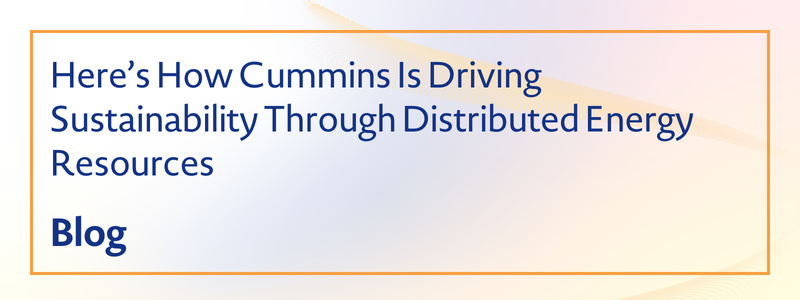Here’s How Cummins Is Driving Sustainability Through Distributed Energy Resources


With sustainability being such a hot topic across the world, it’s no wonder more and more companies are looking for ways to make themselves more environmentally friendly.
Making operations more sustainable is not only good for the planet, but also good for the reputation of your brand, with many people – especially those belonging to the younger generations – choosing to do business with companies with an ethos which reflects their own.
In the world of field service, one of the best methods we have available to contribute towards a more sustainable planet is to assist clients with better management of their assets. By focusing on factors such as energy consumption – a major contributor of carbon emissions – brands can lessen their environmental impact and benefit their bottom line through cost savings to boot.
Cummins Engineering
As one of the world’s most well-known engineering brands, Columbus, Indiana based Cummins Engineering specializes in alternative fuel engines and generators, and related components and technology, giving it a unique insight into the world of power consumption and wastage.
This has led this innovative brand to promote Distributed Energy Resources heavily within and without its own operations as a method of providing better value to the electricity grid and everything which relies on it.
Distributed energy resources are small scale electricity supply or demand power generation resources which are normally located close to load centers. They can provide power to key areas either individually or in aggregate.
"Distributed energy resources are a category of power generation resources defined by their size and their location," writes Cummins in a blog post. "Definitions vary, but few physical distributed energy resources would be larger than a couple of megawatts. Natural gas generators, microturbines, run-of-the-river hydro units, solar arrays, wind turbines, and battery energy storage units are all common sub-megawatt distributed energy resources."
Because they are far smaller than traditional power plants, distributed energy resources benefit the environment in several ways, such as using less land and not requiring significant infrastructure upgrades to install and maintain. Also, while some diesel generators fall into the category of distributed energy resources, they are mostly powered by renewable energy sources such as the Sun, wind, and water.
Distributed Energy Resources
Because of their size and low levels of pollution, distributed energy resources can be installed more easily in urban environments, or even individual buildings, and provide better levels of on-demand energy provision than traditional power plants.
This creates an environment where energy provision can be more easily and flexibly scaled up or down according to demand, saving energy and costs as part of the deal. Many distributed energy resources also possess battery storage capabilities meaning any excess power generated can be retained for future use instead of wasted – further adding to the environmental and cost benefits of the distributed energy resource paradigm.
"Battery energy storage systems of all scales exist, from large centralized systems with several hundred megawatt-hours of capacity to home battery packs rated for a few kilowatt-hours," writes Cummins. "The latter can be included in virtual power plant aggregations along with demand response contracts. Residential energy storage aggregations are actually an innovation that has only recently been deployed at scale."
From a field service perspective, distributed energy resources also make the business of servicing and maintaining these sites infinitely simpler.
They can be located more readily in urban areas, significantly cutting down on the travelling time necessary to reach them and, instead of being sprawling sites spread across multiple buildings and levels, they are normally far smaller and easier to navigate. Typically, being more modern facilities, they are also more likely to be digitally enabled, allowing for innovative technology such as Internet of Things sensors to be installed which can make services such as predictive maintenance possible.
"Distributed energy resources have been so successful they have almost entirely displaced traditional power generation units for certain categories of ancillary services," continues Cummins. "In the UK, for example, more than 90% of ancillary service capacity contracts awarded by the grid operator in the past several years have gone to aggregated demand-response resources, energy storage units, or hydroelectric power plants. distributed energy resources may thus have contributed to the retirement of coal and gas-fired power plants."
Final Thoughts
Distributed energy resources have the potential to be less costly, more environmentally friendly, and easier to service and maintain than traditional power plants. With a heavyweight of the industry such as Cummins throwing its bulk behind the concept this is likely to be one to watch moving forwards.
Better energy management is set to be a hot topic at Field Service Palm Springs 2022, taking place in April at the JW Marriott Desert Springs.
Download the agenda for more information and insights.